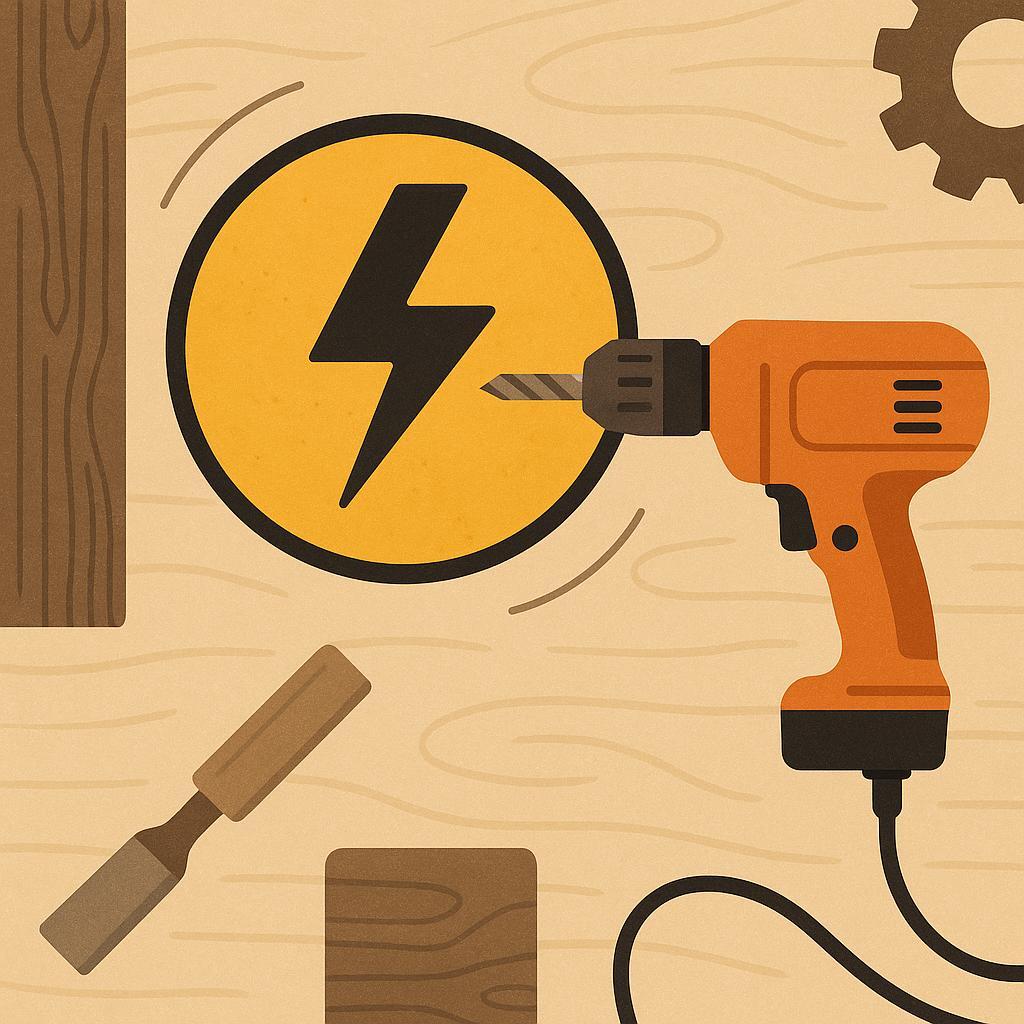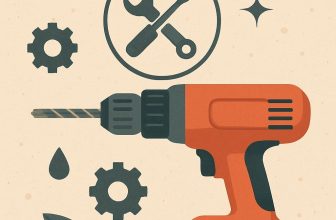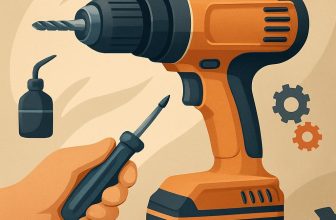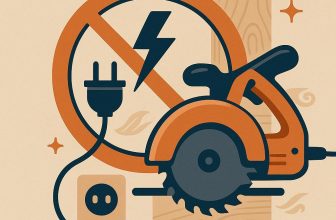
Power tools turn rough timber into finished beauty, but thay can bite when safety is forgotten. In the workshop, electrical risks hide in plain sight-cords fraying under dust, outlets overloaded, damp floors near a spinning blade. This matters to woodworking enthusiasts who demand clean lines and steady hands. The article walks you through practical, no-nonsense safety steps you can apply today: choosing grounded and double-insulated tools, using GFCIs, inspecting cords, organizing extensions, and avoiding moisture.You'll gain a clear checklist, mindful habits, and the confidence to troubleshoot on the fly, so every project stays productive-and safe.
:
Electrical safety Essentials For Grounding And GFCI Protection In Woodworking
Electric safety in a wood shop hinges on solid grounding and reliable GFCI protection.Proper setup means that metal tools have a dedicated path to earth, and that any stray fault current trips the circuit before a person or a tool can be harmed. To start, verify every receptacle you plan to use is grounded, use 3-prong plugs, and keep an eye on damaged cords. Actionable basics:
- Use only grounded outlets on a dedicated or well-filtered circuit for power tools.
- inspect cords and plugs before each session; replace cracked insulation or missing grounding prongs.
- Avoid adapter plugs that defeat grounding; replace two-prong tools with a properly grounded version.
Grounding isn't just about the plug-it's about the entire tool's chassis and metal surfaces. If a fault occurs, current should flow through the grounding conductor and trip the protection device, not through you. Keep these habits in mind: never rely on a tool's plastic housing as a ground, run cords so they don't cross benches or get caught in blades, and use heavy-duty, outdoor-rated or job-site extension cords with continuous-ground protection.
GFCI protection adds a crucial safety layer by sensing imbalance between hot and neutral wires and cutting power in a fraction of a second. In woodworking spaces, install GFCI outlets on all receptacles in damp or dusty areas, and test them regularly. To keep things simple, follow a quick routine:
- Plug in a tool, press TEST on the GFCI; the outlet should cut power to the tool.
- Press RESET to restore power; re-test with the TEST button shortly after.
- If the GFCI trips without a tool plugged in, inspect cords and moisture exposure or consult a licensed electrician.
Key GFCI testing steps at a glance:
| Step | Action | Expected Result |
|---|---|---|
| Test | Press the TEST button | Power to the outlet is cut |
| Reset | Press the RESET button | Power is restored; tool runs again |
| Troubleshooting | If it trips unexpectedly | Inspect cords or call a pro |
integrate grounding and GFCI protection into your shop layout. Keep tools off wet walls, store extension cords neatly when not in use, and protect receptacles from dust with conduit or covers. Consider a dedicated, GFCI-protected circuit for high-draw machines such as planers or dust collectors, and label circuits clearly so you can shut off power quickly if a problem arises.
Build Your Dream Workshop on a Budget →
Inspect Cords Plugs And Tool Bodies for Wear To Prevent Electrical Shock In The Workshop
Begin each session with a careful visual and tactile check of the power cord. run your fingers along the insulation to detect nicks, cracks, or melted patches, and pay close attention to the points where the cord enters the tool and the plug. Any fraying, kinks, or swollen insulation is a warning sign. If you find damage, stop using the tool and replace the cord or have the cord assembly serviced by a qualified technician. Always choose a cord and plug rated for the tool's amperage, and avoid improvised repairs such as tape that simply masks a fault.
Next, examine the plug and the outlet connection. Damaged, bent, or loose prongs, or a plug that feels hot or scorched, indicate a serious issue. Ensure your tool uses a grounded three-prong plug where required,and never bypass grounding with adapters or two-prong converters. If you notice wear, replace the plug, cord, or outlet before continuing, and unplug and re-test connections in a dry, dry area.For extra protection in a workshop habitat, use a GFCI-protected outlet and test it regularly with the built-in test button.
| Wear signs (cords) | What to do |
|---|---|
| Cracked insulation or exposed wires | Stop using the cord and replace the cord or tool assembly |
| Frayed or damaged cord near entry/strain relief | Replace the cord; inspect strain relief and cord routing |
| Loose, bent, or scorched plug prongs | Replace plug/cord or outlet; avoid using until fixed |
| Discolored, melted, or burnt-looking plug or cord | Do not use; replace components and test the circuit |
Inspect the tool's body for overheating and structural wear.Cracks, gaps, or discoloration in the housing can let dust and moisture intrude and expose conductors. Look for loose screws, damaged switch covers, or signs of moisture inside the housing. Ensure the cord entry has a sturdy strain relief that clamps the cord without abrading the insulation. If you detect any deformation, moisture, or abnormal heat after short operation, seal the tool out of service and arrange professional inspection or repair.
Adopt a simple, repeatable safety routine to keep cords and tools in check. Always unplug before inspecting or changing attachments; wipe away workshop dust that can hide wear; store tools with cords neatly coiled to reduce bending; keep a small stock of OEM cords and plug assemblies on hand for quick replacements; and clearly label any tool or cord as out of service until repairs are completed. For ongoing protection, prefer OEM parts and modern safety features such as GFCI outlets and proper strain-relief hardware in your workshop.
Build your Dream workshop on a budget →
Safe Extension Cord and Power Strip Practices For Woodworking Projects
Safe extension cords and power strips are a lifeline in a woodworking setup. When you're trimming, routing, or cutting, dependable power delivery means fewer tool stalls and safer work.Choose cords that are rated for the task: aim for at least 12 AWG for most shop runs, and favor heavy-duty, outdoor-rated cords with grounded plugs. Keep extensions as shorter runs whenever possible to minimize voltage drop and heat buildup. Before each project, inspect cords for nicks, cracks, or damaged insulation and replace any that feel warm to the touch.
Power strips can be convenient, but they're not a substitute for a proper outlet plan. Use a dedicated,surge-protected strip only for small tools or chargers,not for the entire workshop. Never daisy-chain power strips or plug high-draw tools into a single strip. Instead,plug high-draw devices directly into a wall outlet or a fixed power distribution solution. Keep cords and strips away from damp areas and route them along the edge of benches where they won't be snagged by clamps or moving equipment.
Here's a quick-reference table to help you match run length with cord gauge for typical shop setups:
| Run Length | Cord Gauge | Best Use |
|---|---|---|
| Up to 25 ft | 14 AWG or heavier | General hand tools |
| 25-50 ft | 12 AWG | Power tools like drills, sanders |
| Over 50 ft | 10 AWG | High-draw tools; consider fixed outlets |
commit to ongoing maintenance and association: inspect cords regularly, unplug tools when not in use, and coil cords loosely for storage to prevent kinks. Use a dedicated outlet or a properly rated surge-protected strip for each high-draw tool,label cords so you know which tool they serve,and avoid routing cords across dust collectors or near finishing stations where heat can accumulate. If you're working in a damp area or near water, favor GFCI-protected outlets and keep moisture away from plug ends to reduce shock risk.
Build Your Dream Workshop on a Budget →
Set Up A Clean Dry And Organized Work Area To Minimize Electrical Hazards
A clean, dry, and organized work area is a foundational safety habit. It reduces clutter that can conceal damaged cords, damp surfaces, and accidental contact with live plugs. Start with a dry bench, sweep up sawdust, and designate separate zones for cutting, assembly, and electronics to minimize movement around powered tools. A non-slip mat under the machinery and a spill tray for liquids help keep floors safe and dry.
Protect cords and outlets as you work. Use grounded outlets and keep extension cords fully rated for the tool's amperage, avoiding daisy-chaining. Inspect cords before each use for cracks or exposed wires; replace damaged insulation immediately. Place cords along walls or overhead when possible, and unplug tools when changing blades or bits. Keep water, solvents, and other liquids away from electrical connections to prevent arcing and shocks.
Smart cable management and tool storage reduce hazards and improve efficiency. Route cords with hooks or cable channels, keep the plug end away from the dust stream, and store commonly used cables where they won't tip or snag on clamps.use a simple table below as a quick reference for layout and checks.
| Area | Action |
|---|---|
| Floor | Keep clear; wipe spills; use non-slip mats |
| Outlets & Cords | Inspect daily; use wall hooks; avoid daisy-chaining |
| Tool Storage | Store unplugged; label locations |
Maintain the routine with a simple daily quick-check and a weekly deeper review. At the end of each session, perform a five-minute tidy: confirm all tools are unplugged, cords are coiled neatly, and the work surface is dry.Regularly test GFCI outlets and keep moisture away from electrical components to sustain a safe woodworking environment.
Build Your Dream Workshop on a Budget →
Safe Start Up And Shutdown Procedures For Power Tools In The Shop
Establishing a safe start-up routine for every power tool helps prevent common injuries in a busy woodworking shop. Before you flip a switch, verify that the tool is off, guards are in place, and the blade or bit is correct for the job. Inspect cords and plugs for wear, secure loose clothing, tie back hair, and clear the work area of offcuts and trip hazards. Ensure the dust collection system is ready to capture chips, and clamp your stock securely so it doesn't shift during the cut.
| Step | Action | Rationale |
|---|---|---|
| Power off & inspect | Ensure switch is OFF and cords/guards are intact | Prevents unexpected starts and injury |
| secure setup | Clamp stock and align fence | Minimizes kickback and chatter |
| Check dust & guards | Confirm dust collection active and guards operational | Improves visibility and safety |
| Low-load test | power on and run without cutting | Verifies operation before cutting material |
With the tool ready, follow a clear start-up sequence that minimizes surprises. Ensure the switch is in the OFF position, then connect power only after guards are seated and the workpiece is secured. Set the correct speed for the task, align fences or stops, and verify that all safety devices including riving knives and blade guards are ready. Do a brief, quiet test run without load to confirm the spindle spins smoothly, the guard/opening mechanism works, and the dust extractor is drawing. When using soft-start capable equipment, allow the motor to reach speed gradually rather than forcing it to surge.
Shutdown should be as purposeful as the start-up. Turn the tool OFF and, if available, switch it off at the power outlet, then unplug before performing any blade or bit changes. Wait for the cutting edge to come to a complete stop, then release clamps and remove the workpiece. Inspect the area for scraps, collect chips, and wipe surfaces clean. Store accessories in their designated spots and store blades or bits in a secure container. re-check that guards are in place and the tool is cool and safe before covering or returning it to its cabinet or bench.
Build Your Dream Workshop on a Budget →
Regular Maintenance And Inspection Of Tools Cords And Accessories For Electrical Safety
Regular maintenance and inspection of cords and accessories is a cornerstone of safe woodworking with power tools. Start by giving cords a visual and tactile check before every session: look for cracks, kinks, or crushed insulation; feel for heat along the length after brief use; and ensure the cord lays away from blades, dust, and water. Store cords and accessories off the floor and away from solvents or oils that can degrade insulation. Clean tools and cords with a dry cloth, avoiding any moisture that could seep into electrical components.
During use,pay attention to the condition of plugs,connectors,and strain relief. Inspect plug prongs for bending or tarnish, test grounding by a quick plug-in test, and examine the cord entry points where the cable meets the tool. If you notice cracking insulation,exposed wires,or a loose connection at the tool's inlet,stop using the tool immediately and set it aside for inspection or replacement. Damage like these can cause electric shock or fire long before you realize any problem.
To keep things systematic, use a concise maintenance checklist for cords and accessories. The following table captures key areas to check and the recommended action if a fault is found.
| Item | What to Check | Action If Fault Found |
|---|---|---|
| Cord insulation | Cracks, nicks, brittleness | Replace cord or tool; stop use |
| Plug and connectors | Bent prongs, looseness | Replace plug/adapter; retest |
| Strain relief | Cracking, stiffness | Repair or replace |
| Moisture exposure | Damp or wet conditions | Dry thoroughly; do not use until dry |
| Extension cords | Overheating, damage | Limit length; replace damaged cord |
document and tag any tool or cord that requires maintenance or has been replaced. Create a simple log noting date, issue, and action taken, so you can track when components were last inspected. When in doubt, err on the side of safety: if a cord shows even minor damage, retire it and upgrade to a certified, properly rated extension or replacement part. Keeping your cords and accessories in top condition reduces the risk of electric shock, short circuits, and tool downtime, letting you focus on precise, safe woodworking.
Build Your Dream Workshop on a Budget →
Q&A
How can I ensure proper grounding and electrical protection when using power tools in a wood shop?
Use a grounded outlet (three-prong) and GFCI in damp or woodshop areas.Inspect cords and plugs for cracks or exposed conductors, and retire damaged tools. Use an extension cord rated for the tool's amperage,and keep cords away from cutting paths. Never bypass safety devices or yank cords at the plug.
What steps should I take before starting a woodworking session to prevent electrical hazards?
Do a quick visual check of the tool, cord, and switch before use. Unplug tools when changing bits, blades, or leaving the work area. Keep hands and the workspace dry, and avoid running cords through wet areas or across busy walkways.don't daisy-chain multiple extension cords to power a single tool.
How should I manage dust collection and electrical safety together?
Use a dust extraction system compatible with your tools and, if possible, on its own circuit. Keep hoses and cords organized and off the floor to prevent trips and moisture contact. If using a metal dust collector, ensure proper grounding and avoid routing electrical connections near damp or dusty zones.
What should I do if a tool or outlet shows signs of heat, buzzing, or burning smell?
Unplug the tool at the outlet immediately and stop using it. Let it cool, then inspect for damaged cords, worn brushes, or signs of overload. If repairing it isn't safe or possible, have a qualified technician diagnose and repair the tool and replace any damaged components.
Concluding Remarks
ultimately, the core message is simple: safety is not a hurdle to creativity but the engine that keeps it running. When you plan, inspect, unplug, and wear the right PPE, you protect both your hands and your hours of woodworking wonder-the cuts clean, the shavings tidy, the project true.For enthusiasts, a mindful routine means more projects complete, fewer surprises, and a space where curiosity can thrive without fear. So pick a project, browse the guides, and start applying these habits today. With careful habits and steady hands, your workshop becomes a place where craftsmanship grows, and every cut ends with a confident, hopeful finish.







These tips are essential for anyone who enjoys woodworking! Safety should always come first, especially when using power tools. Thanks for sharing!
Great insights! It’s so important to stay vigilant while working with power tools; a little caution can go a long way in preventing accidents. Always keep your workspace organized and wear the right protective gear!
These tips are a must-read! Proper electrical safety can truly make a difference in your woodworking projects, ensuring that creativity flows without the risk of injury. Thanks for highlighting these important precautions!
Absolutely agree, Corey! Safety should never be compromised when it comes to woodworking. It’s great to see these electrical safety tips being shared to help everyone stay safe and enjoy their craft without worry!
Well said, everyone! Implementing these electrical safety measures not only protects us but also enhances our overall woodworking experience, allowing us to focus on what we love-creating beautiful pieces!
I completely agree, Corey! Following these electrical safety tips not only safeguards us while using power tools but also allows us to keep our focus on the artistry of woodworking-after all, a safe workshop is a happy workshop!
I couldn’t agree more! Prioritizing electrical safety is essential for enjoying woodworking to the fullest. With the right precautions in place, we can hone our skills and create amazing projects without fear. Let’s keep our workshops safe and our imaginations thriving!
Absolutely, safety is paramount in woodworking! By following these electrical safety tips, we can not only protect ourselves but also inspire confidence in our creative process. Here’s to crafting with care and creativity!
I totally resonate with all the previous comments! Emphasizing electrical safety in woodworking is crucial to ensuring not only our personal safety but also the quality of our projects. Let’s always remember to be vigilant and maintain a secure environment so we can fully enjoy the creative journey!
I couldn’t agree more with all the fantastic points made! It’s so important to stay safe while working with power tools, as it not only protects us but also ensures that we can fully immerse ourselves in the joy of woodworking. Let’s keep safety at the forefront of our creative journeys!
I wholeheartedly support the emphasis on electrical safety in woodworking! By adhering to these tips, we not only protect ourselves but also create a productive and enjoyable environment where our creativity can flourish. Here’s to safe crafting and endless inspiration!
I completely echo the sentiment about the importance of electrical safety! Implementing these tips not only safeguards our well-being but also allows us to focus on the joy of creating without any distractions. Here’s to safe and successful woodworking adventures for everyone!
I completely agree with everyone here! Prioritizing electrical safety while using power tools is essential for both our health and the success of our projects. Let’s keep sharing tips and best practices so we can all enjoy woodworking safely and creatively!
Absolutely! Prioritizing electrical safety is key to a successful woodworking experience, and I love seeing everyone share their insights. Let’s keep this conversation going to ensure that all of our projects are safe and enjoyable!
Absolutely! It’s inspiring to see everyone emphasize the critical role of electrical safety in woodworking; by staying informed and sharing our experiences, we can all foster a safer environment where creativity thrives. Let’s continue to support each other in making every project enjoyable and incident-free!
I couldn’t agree more with all the wonderful insights shared here! Maintaining vigilance with electrical safety while using power tools truly is paramount; it’s all about ensuring our workshops are not only productive but also safe spaces for creativity. Let’s keep sharing our tips and experiences to inspire one another!